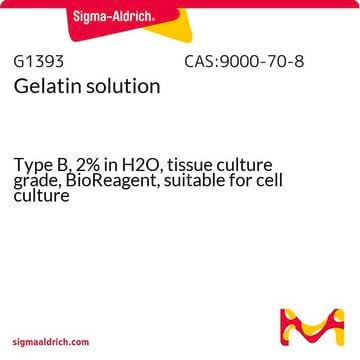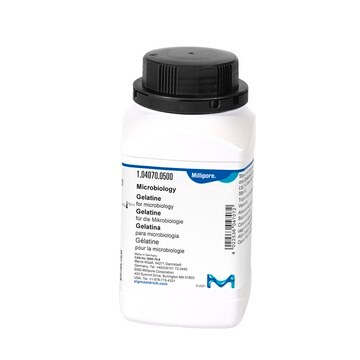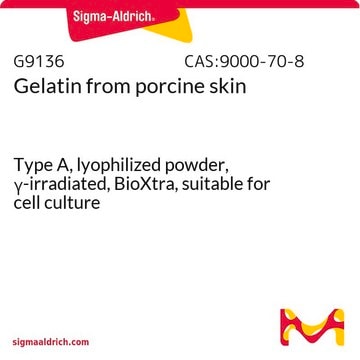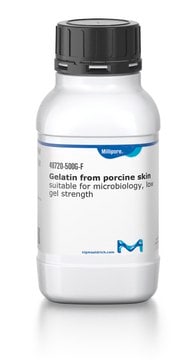The bulk density of this product is not determined.
G9382
Gelatin from bovine skin
gel strength ~225 g Bloom, Type B
Sinonimo/i:
Bovine gelatin
Scegli un formato
Scegli un formato
About This Item
Prodotti consigliati
Origine biologica
bovine skin
Livello qualitativo
Tipo
Type B
Saggio
≥95% protein basis (biuret)
Stato
powder
tecniche
ELISA: suitable
cell culture | mammalian: suitable
immunocytochemistry: suitable
western blot: suitable
Solubilità
H2O: soluble 50 mg/mL
Cerchi prodotti simili? Visita Guida al confronto tra prodotti
Componenti
Avvertenza
Nota sulla preparazione
Codice della classe di stoccaggio
11 - Combustible Solids
Classe di pericolosità dell'acqua (WGK)
nwg
Punto d’infiammabilità (°F)
Not applicable
Punto d’infiammabilità (°C)
Not applicable
Dispositivi di protezione individuale
Eyeshields, Gloves, type N95 (US)
Scegli una delle versioni più recenti:
Certificati d'analisi (COA)
Non trovi la versione di tuo interesse?
Se hai bisogno di una versione specifica, puoi cercare il certificato tramite il numero di lotto.
Possiedi già questo prodotto?
I documenti relativi ai prodotti acquistati recentemente sono disponibili nell’Archivio dei documenti.
I clienti hanno visto anche
-
What is the bulk density of this product
1 risposta-
Utile?
-
-
What is the molecular weight of this Gelatin?
What is the molecular weight of this Gelatin?
1 risposta-
The molecular weight of this product has not been evaluated, However, the molecular weight is closely related to the Bloom Number. The estimated ranges are as follows:
Bloom Number Average Molecular Mass (Da)
50−125 (Low Bloom) 20,000−25,000
175−225 (Medium Bloom) 40,000−50,000
225−325 (High Bloom) 50,000−100,000Please see the link below to review the general datasheet for Gelatin:
https://www.sigmaaldrich.com/deepweb/assets/sigmaaldrich/product/documents/333/625/g9382pis.pdfUtile?
-
-
How to sterilize 2% solution?
1 risposta-
This item can be sterilized by autoclaving at 121°C, 15 psi for 30 minutes.
Utile?
-
-
Which is the molecular weight?
1 risposta-
The Bloom number or gel strength of this product is ~225 g Bloom. The average molecular mass of 175-225 g Bloom (Medium Bloom) products is 40,000-50,000 Da. The average molecular mass of 225-325 g Bloom (High Bloom) products is 50,000-100,000 Da. Therefore, this product is expected to have a molecular weight of approximately 50 kDa.
For more information please view the product data sheet: https://www.sigmaaldrich.com/deepweb/assets/sigmaaldrich/product/documents/187/614/g6650-et-al-pis-ms.pdf
Utile?
-
-
Is this made from skin from a cow which was killed for the food chain?
1 risposta-
All information that is shared regarding source can be found on a lot-specific Certificate of Origin (CofO, COO) for this product.
Utile?
-
-
How does the storage temperature relate to shipping conditions?
1 risposta-
The storage conditions that a Sigma-Aldrich catalog and label recommend for products are deliberately conservative. For many products, long-term storage at low temperatures will increase the time during which they are expected to remain in specification and therefore are labeled accordingly. Where short-term storage, shipping time frame, or exposure to conditions other than those recommended for long-term storage will not affect product quality, Sigma-Aldrich will ship at ambient temperature. The products sensitive to short-term exposure to conditions other than their recommended long-term storage are shipped on wet or dry ice. Ambient temperature shipping helps to control shipping costs for our customers. At any time, our customers can request wet- or dry-ice shipment, but the special handling is at customer expense if our product history indicates that the product is stable for regular shipment.
Utile?
-
-
What is a Bloom number, and how does it correlate with the molecular weight?
1 risposta-
The Bloom number is indicative of gel strength. The Bloom number is the amount of pressure, in grams, required to break the surface of a 6.67% gel. The general rule of thumb in regards to an average molecular weight: High Bloom (225-325) = 50,000-100,000; Medium Bloom (175-225) = 40,000-50,000; Low Bloom (50-125) = 20,000-25,000. Product G9382 is a high Bloom preparation of approximately 225 Bloom.
Utile?
-
-
What is the difference between type A and type B gelatin?
1 risposta-
Type A gelatin is derived from acid-cured tissue whereas Type B gelatin is derived from lime-cured tissue. Type A gelatin has about 78-80 millimoles of free carboxyl groups per 100 g of protein and a pI of 7.9-9.0. Type B has 100-115 millimoles of free carboxyl groups per 100 g of protein and a pI of 4.7-5.2.
Utile?
-
-
What is the isoelectric point (pI) for Product G9382, Gelatin from bovine skin?
1 risposta-
The pI for Product No. G9382 is typically in the range of 4.7 - 5.0.
Utile?
-
-
What is Product G9382, Gelatin from bovine skin, soluble in?
1 risposta-
Gelatin is soluble in glycerol and acetic acid, and more soluble in hot water than in cold water. We test the solubility of gelatin in water at 50 mg/mL (with heat).
Utile?
-
Filtri attivi
Il team dei nostri ricercatori vanta grande esperienza in tutte le aree della ricerca quali Life Science, scienza dei materiali, sintesi chimica, cromatografia, discipline analitiche, ecc..
Contatta l'Assistenza Tecnica.















